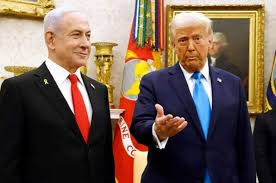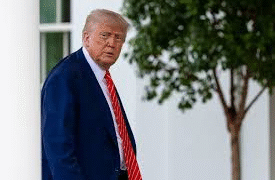Former President Donald Trump is scheduled to visit Egypt and Israel as a ceasefire agreement takes effect in Gaza, marking a key moment in ongoing Middle East diplomacy
Trump’s Middle East Mission: Timing, Stakes, and Context
As a fragile ceasefire takes effect in the Gaza Strip, former U.S. President Donald Trump is preparing a high-profile diplomatic trip to Egypt and Israel. The visit underscores both the promise and peril of peacemaking in a region long beset by conflict — and highlights Trump’s ambition to position himself as a central actor in Middle East diplomacy.
The planned trip comes at a moment of cautious optimism. On October 9, 2025, Israel and Hamas signed off on the first phase of a 20‑point ceasefire plan proposed by Trump, entailing the release of hostages, a gradual Israeli withdrawal, and a pause in active hostilities.
Now, as hostilities subside and diplomatic energy intensifies, Trump’s journey signals several intertwined aims: to cement his role in brokering the peace agreement, to underscore U.S. influence in the region, and to navigate the complex relationships among Israel, Egypt, and the broader Arab world.
Background: How the Ceasefire Deal Emerged

Trump’s 20‑Point Peace Plan and the Negotiation Push
On September 29, 2025, Trump unveiled a detailed 20‑point framework for ending the Gaza conflict. The plan included immediate steps (such as laying out the mechanics of a hostages‑for‑prisoners exchange) and longer-term provisions (a transitional governing authority in Gaza under international oversight).
To translate that framework into action, the United States dispatched key envoys — including Trump’s son-in-law Jared Kushner and negotiating expert Steve Witkoff — to Egypt, where indirect talks between Israel and Hamas were taking place in Sharm el-Sheikh.
As tensions rose, Trump himself signaled that he would travel to Egypt to attend the formal signing ceremony. “We’re going to get over there,” he told reporters, while indicating that the exact timing was still under negotiation.
Egypt’s President Abdel Fattah al-Sisi formally renewed that invitation, urging Trump’s presence at the signing to underscore its importance and legitimacy.
Key Provisions of the Ceasefire Agreement

The ceasefire deal (in its first phase) includes:
- Cessation of hostilities: Once Israel’s cabinet ratifies the agreement, fighting is to stop and aid access to Gaza is to increase.
- Israeli withdrawal: Israeli forces are to pull back to predetermined lines, with the process to be completed within 24 hours of ceasefire ratification.
- Hostage release: All Israeli hostages still alive in Gaza are to be freed within 72 hours after the withdrawal. Deceased captives’ remains are to be returned in parallel.
- Prisoner exchange: In tandem with the Israeli hostages’ release, a number of Palestinian detainees held by Israel will be freed.
- Longer-term governance & reconstruction: The plan envisions a new transitional Palestinian administration (excluding Hamas), the formation of a multinational stabilization force, and funding by wealthy nations in the Arab world to rebuild Gaza.
Analysts note, however, that these initial steps leave open many thorny issues — especially the question of disarming Hamas, ensuring sustainable governance, and preventing a relapse into violence.
Objectives and Symbolism of Trump’s Visit

Trump’s planned trip carries both symbolic weight and strategic purpose. Here are some key goals and implications:
1. Anchoring U.S. Leadership in the Process
By physically showing up in Cairo and Jerusalem, Trump aims to present himself as a key broker, not just a back‑channel facilitator. The optics of a U.S. leader overseeing the signing and traveling to partner capitals reinforces U.S. influence in the evolving regional architecture.
2. Reassuring Allies & Building Momentum
Egypt has played a central mediating role in the deal — hosting the talks, coordinating logistics, and liaising with both the Hamas and Israeli delegations. Sisi’s renewed invitation to Trump underscores Cairo’s desire for international legitimacy and shared responsibility.
On the Israel front, Prime Minister Netanyahu has welcomed the agreement as a diplomatic and morale victory. Trump’s presence is likely to be used to shore up political support among Israel’s coalition partners and signal U.S. backing for Israel’s security while endorsing pragmatic compromise.
3. Cementing the Ceasefire and Preventing Backsliding
Peace accords often crack under implementation pressures. A high‑level visit puts a layer of accountability on all sides — reinforcing commitments, spotlighting violations, and maintaining international attention during the sensitive “cool down” period.
4. Laying Groundwork for Reconstruction and Governance
One of Trump’s more ambitious ideas is the creation of a “Board of Peace” to supervise Gaza’s reconstruction, in which wealthy Arab states would play a leading role. His visit could help catalyze pledges, coordinate donor meetings, and launch initial projects on site.
5. Domestic Political Messaging
Beyond the region, Trump’s trip is also a signal to U.S. and global audiences: that he can still act decisively on foreign policy, navigate complex diplomacy, and broker peace in a hotspot of enduring conflict. For supporters and critics alike, the visit will be a test of how much influence Trump retains in world affairs.
Challenges, Risks, and Skepticism

Despite momentum, the trip and the ceasefire implementation face considerable pitfalls.
Fragile Ceasefire: Violations & Distrust
Historically, ceasefires in Gaza have been brittle. Any violations in the coming days — rocket fire, raids, unauthorized movements — can unravel momentum and trigger renewed fighting. With tensions still raw, maintaining discipline on all sides will require strict supervision and quick responses to breaches.
Governance and Disarming Hamas
One of the most challenging aspects lies ahead: how to govern Gaza after the ceasefire. The deal envisions a technocratic interim authority without Hamas participation, and the disarmament of Hamas’ military wing. However, Hamas has resisted ceding power or disarming in past deals, raising questions about enforceability and political legitimacy.
Balancing security and inclusion will also be delicate: excluding Hamas entirely risks alienating large segments of the Gaza population, while allowing it to play a role raises fears among Israel and regional states about renewed militancy.
Reconstruction, Funding, and Accountability
Rebuilding Gaza is an immense task: millions displaced, infrastructure destroyed, basic services collapsed. The plan relies heavily on financial contributions from wealthy Arab states — a significant ask, especially given domestic priorities in those nations. Ensuring transparency, equitable distribution, and avoiding corruption or favoritism will require close oversight.
Trump’s “Board of Peace” concept, if it advances, may become a focal point — but coordination among donor states, local agencies, and on-the-ground NGOs will be complex.
Political Pushback and Hardliners
In Israel, right-wing factions have long opposed negotiated deals with Hamas, seeing them as capitulation. Some coalition members could derail cooperation or demand tougher security assurances.
On the Palestinian side, factions skeptical of Trump’s approach or wary of external control over Gaza may resist or undermine the process. There’s also skepticism in broader Arab and Muslim public opinion over U.S. incentives and fairness — any perception of bias toward Israel could provoke backlash.
Logistical and Security Risks
A trip of this nature is not without risks. Security in Israel and Egypt remains tense; protests by displaced Palestinians or victims’ families may escalate. Unforeseen incidents could strain or postpone the visit. Moreover, coordination among U.S., Egyptian, Israeli, and Palestinian security services must be seamless.
Overshadowed Themes: Palestinian Statehood, West Bank, Refugees
Even as the focus narrows to Gaza, the broader Palestinian issue looms: the status of the West Bank, the question of East Jerusalem, Palestinian refugees, and the recognition of statehood. Critics may say the deal sidelines core Palestinian demands or freezes momentum toward two-state solutions.
What Trump’s Visit Might Look Like

Itinerary Highlights (Projected)
- Cairo: Trump may be present for the formal signing event of the ceasefire deal. He could meet President Sisi, address Egyptian leadership, and participate in a joint press conference. This will solidify Egypt’s role as host and mediator.
- Jerusalem / Tel Aviv: While details remain tentative, Trump may address the Knesset (Israel’s parliament) — a powerful symbolic moment if confirmed — and meet with Prime Minister Netanyahu and other Israeli leaders.
- Gaza (Possibility): Some reports suggest Trump may consider visiting Gaza itself, though security and logistics will make this complex and potentially controversial.
Key Messages to Expect
- Commitment to peace and implementation: Trump will likely frame the agreement as a turning point — not just a ceasefire, but a starting framework for durable peace.
- Security assurances: He may reaffirm U.S. and allied guarantees to Israel’s security, while promising oversight and coordination in Gaza to prevent a resurgence of militant activity.
- Humanitarian urgency and reconstruction pledges: Trump will probably spotlight Gaza’s humanitarian crisis and appeal to Arab states to commit to reconstruction assistance.
- International legitimacy and multilateralism: He will seek to present the deal as backed by regional partners (Egypt, Qatar, Turkey, Arab states) — not just a U.S.-led imposition.
- A call for vigilance and accountability: Given the risks of violations, Trump may emphasize mechanisms for monitoring, responding to infractions, and maintaining pressure on parties to comply.
Regional and Global Reactions

Egypt and Arab States
Egypt positions itself as a linchpin in regional diplomacy. Sisi has expressed strong support for Trump’s role and called for an immediate cessation of hostilities. 2 Arab states, including Qatar, Turkey, Saudi Arabia, and the UAE, have played mediation or financial roles — and may use Trump’s visit to solidify pledges or public buy-in.
Some Arab leaders may view the visit as a U.S. attempt to reassert influence in the region, especially amid competition from China, Russia, and regional powers. The optics could help reassess alliances and diplomatic posture in the Middle East.
Israel
Israeli leadership largely welcomes the agreement as a diplomatic achievement, but elements within the government remain wary. Trump’s visit may calm internal coalition tensions, reassure hardliner factions, and strengthen political legitimacy. His presence may also be leveraged to boost Israel’s standing internationally.
Palestinians and Hamas
Within Gaza and the West Bank, responses are likely mixed. Many Palestinians, exhausted by war and displacement, will welcome the cessation of fighting and prospects for reconstruction. Others remain cautious, questioning whether Israel or foreign powers will respect Palestinian dignity and sovereignty. Hamas may comply publicly with initial steps but resist deeper disarmament or ceding of control.
International Community
Global actors — from the U.N. to the E.U., Russia, China, and NGOs — will weigh the deal with interest and skepticism. Some will applaud the breakthrough and offer technical or financial support. Others will continue to press on unresolved issues: human rights, accountability for civilian deaths, long-term governance, and fairness in aid distribution.
Trump’s trip may serve as a focal point for international diplomacy, donor conferences, and renewed multilateral engagement on Gaza’s future.
What to Watch: Key Indicators After the Visit
- Adherence to the ceasefire timeline
- Whether Israel fully withdraws to agreed lines
- Whether hostage release happens on schedule
- Reports of ceasefire violations by either side
- Implementation of reconstruction efforts
- Speed and amounts of international funding
- Launch of major infrastructure, health, electricity, water projects
- Transparency and oversight mechanisms
- Formation and legitimacy of Gaza’s interim governance
- Who is appointed, how inclusive it is, and how accountable
- Tension between technocratic management and political legitimacy
- Security and demilitarization of militant capabilities
- How militias or remaining Hamas elements are disarmed
- Establishment of a trained Palestinian security force
- Role of international peacekeeping or stabilization forces
- Political stability in Israel and Egypt
- Domestic pushback from hardline factions or opposition parties
- Continuity of support for Trump’s role among allies
- Potential defections or challenges to agreements
- Regional ripple effects
- How Lebanon, Syria, Jordan, and Iran respond
- Whether the deal encourages broader normalization or further conflict
- Whether other regional disputes (e.g. Iran relations) shape the narrative
Conclusion

Trump’s intended visit to Egypt and Israel, timed with the fragile onset of a Gaza ceasefire, is laden with ambition, symbolism, and risk. On one hand, the trip offers an opportunity to solidify a diplomatic breakthrough, reinforce U.S. leadership, and galvanize reconstruction and governance efforts. On the other, the success of the mission hinges on delicate execution — in diplomacy, security, and follow-through.
Whether this moment becomes a lasting turning point or a fleeting diplomatic flourish will depend not just on what happens in Cairo or Jerusalem, but on what unfolds in Gaza, among the peoples affected, and in the halls of power across the region.
Also Read : Kerala Suvarna Keralam Lottery SK-22 Result Announced: RT 265228 Wins ₹1 Crore First Prize















 Categories
Categories









